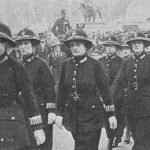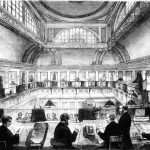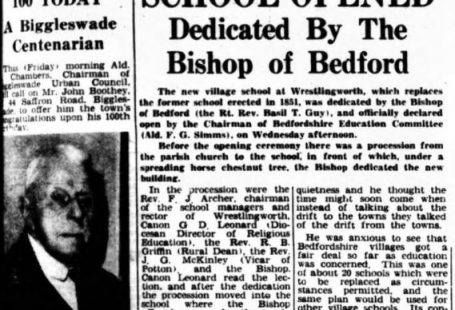This week at The Archive we have been working hard to bring you an incredible 120,386 brand new pages – as well as twelve brand new titles in all! To celebrate St David’s Day this week, we have added a grand total of five brand new Welsh titles to our collection, including three historic Welsh-language newspapers.
So read on to discover more about this bumper crop of new titles, and also to discover how St. David’s Day was celebrated in the Victorian era (hint, think food!).
Register now and explore the Archive
With it being St David’s Day this week, it is only fitting to start off with our new Welsh titles. First up is the South Wales Daily Telegram. Established in 1842 as the Cardiff and Merthyr Guardian, this publication became known as the Evening Telegram in 1870, before becoming the South Wales Daily Telegram in 1876. Costing just one halfpenny, this Liberal publication was published in Newport and circulated ‘throughout Monmouthshire.’
Speaking of its switch to an evening edition in August 1870, the South Wales Daily Telegram relates the ‘lively demand for the supply of important intelligence oftener than once in twenty-four hours.’ It aimed to fulfil this need for nearly round-the-clock news, hitting the shelves at 5pm every day and containing ‘the latest District, General, Shipping, Commercial and Telegraphic News, from all parts of the world up to the hour of publication.’
Our next new Welsh title is the Pontypridd District Herald. Published in Pontypridd, Glamorgan, it was the town’s first newspaper and was established in the 1870s. Published weekly on a Saturday, this independent publication cost one penny and circulated in the ‘Rhondda, Aberdare and Merthyr Districts.’ Within its pages you can find sections like ‘Local Jottings,’ ‘Public Notices’ and even a ‘Ladies’ Column,’ which featured articles on fashion and useful tips for the home.
We move now to look out our exciting trio of new Welsh-language titles. Heading these up is Y Llan (The Church). This newspaper was produced by the Anglican church in Wales, and contained general, local, national and international news. It also featured readers’ contributions, and regular reports on religious matters.
We have also published Y Tyst (The Witness) this week. Beginning life as Y Tyst A’r Dydd (The Witness and the Day) in Merthyr Tydfil in 1864, it merged with the Y Tyst Cymreig (The Welsh Witness) in 1874. The only Welsh-language newspaper to be published in the town of Merthyr Tydfil, it was also the ‘Organ of the Welsh Congregationalists throughout the Principality.’ Appearing weekly on a Friday, it circulated throughout South Wales and was described as being ‘one of the best Mediums for General Advertisements.’
Rounding off our trio of Welsh-language titles, and our new Welsh newspapers this week, is Seren Cymru, or the Wales Star. Initially appearing in 1851, its unsuccessful first run was overseen by Samuel Evans in Carmarthen, before it was reestablished in the same town in 1856 under the editorship of J. Emlyn Jones. With a Liberal lean, Seren Cymru circulated ‘throughout the Principality;’ its main content focusing on local, national and foreign news, as well as featuring some more radical viewpoints.
Printer W. Morgan Evans owned the newspaper until 1880, when he sold it to a Baptist company. Seren Cymru is still in publication to this day as part of the Baptist Union of Wales.
We move away now from the Land of Our Fathers to take a look at our other new titles of the week. We begin this foray with the Weymouth Telegram, which was established in 1860 in the Dorset seaside town of Weymouth. A Liberal newspaper, it went on to incorporate the Dorset Leader in 1864, the Weymouth and Dorset Guardian in 1888, and the Dorset County Post, again in 1888.
Amongst the usual local and district news, the Weymouth Telegram also contained such sections as ‘Among the Humorists,’ ‘Woman’s Realm’ (with pieces on dress, fashion and the home), as well as ‘Football Gossip.’ You can also find within its pages a range of illustrations, as well as serialized fiction.
Our next new title is the Warwickshire Herald. Established in 1867, this title occupied ‘a leading position as a County Paper, circulating extensively throughout the various districts’ and was ’eminently suited for giving publicity to the wants of all classes of the public.’
Warwickshire Herald | 28 March 1885
A neutral title, the Warwickshire Herald was published in Birmingham and circulated in that city as well as ‘the adjoining districts, and throughout the county.’ The title featured ‘the local news of Birmingham,’ whilst the news from the ‘suburban districts’ is also ‘fully given.’ Furthermore, the newspaper offered a ‘selection of general intelligence,’ as well as the latest sports news.
We have a trio of Yorkshire titles joining us this week, starting with the Ripon Observer. Established in 1885, this Conservative publication appeared every Thursday and circulated throughout ‘the Ripon Parliamentary Division.’ It contained the usual ‘Local Intelligence’ sections, birth, marriages and deaths notices, serialized fiction, and a ‘Ladies Column,’ which featured household advice, recipes and health hints and tips.
Next up is the Halifax Comet. Established in 1892 as the Halifax Local Opinion, in 1894 it was renamed the Halifax Comet. Appearing every Thursday, it was published by J. Turner Spencer and cost one halfpenny. Its first edition featured this rallying call:
The paramount aim of the Journal is to be free to all, fearless of none, and, whilst ever ready to acknowledge the favour of others by which it exists, to show no special favour by which its impartiality could be questioned.
Halifax Comet | 25 August 1894
The Halifx Comet featured correspondence, local news, full page advertisements, as well as sections like ‘Somebody Wants to Know,’ which contained such questions as whether ‘the prevalence of round shoulders amongst our present-day youth is attributed to cycling?’
Another feature of the Halifax Comet was its inclusion of the The Ha’porth, a journal of ‘Wit, Wisdom, Fiction, Pastime and General Information.’ Richly illustrated, it is a miscellany of musings and anecdotes, featuring, amongst other things, competitions and draughts and chess problems.
Our final new Yorkshire title of the week is the East Riding Telegraph. First published in Beverley on 4 May 1895, it appeared every Saturday priced at one penny. Making ‘no apology’ for its first appearance, its first edition laid out the motto of ‘strict impartiality through independence:’
Every section of the community shall at all times receive fair and honest treatment at our hands. Our columns will be open to all, irrespective of position, creed, or party.
East Riding Telegraph | 18 May 1895
Featuring news from Beverley and the local area, the East Riding Telegraph featured such sections as the ‘London Letter’ (the first edition reporting on the trial of Oscar Wilde), ‘Society Gossip,’ ‘Work and Wages,’ and ‘Wit and Humour.’ It also reported extensively on a range of ‘Sport and Pastimes,’ including football, cricket, rugby league, cycling and lacrosse.
Our penultimate new title of the week is the Southport Visiter. Established in 1844, this Conservative newspaper cost one penny and saw an average weekly sale of 24,519 copies. Circulating in Southport, Lancashire, ‘the most fashionable watering-place on the North-west coast, Ormskirk, and all parts of the kingdom,’ the Southport Visiter set out to ‘advocate the general interests of the borough.’
Southport Visiter | 3 October 1911
Furthermore, it was ‘the only paper in the borough in which all the fashionable arrivals are fully recorded,’ with ‘particular attention’ given to local news and ‘all important events…duly chroncilled.’
Rounding off our new titles this week is the Barrow Herald and Furness Advertiser. This Liberal newspaper was published in the town of Barrow-in-Furness, which was formerly in Lancashire, but is now a part of Cumbria. Appearing on Tuesdays and Saturdays, it circulated in ‘Barrow, the whole of Furness, and the counties of Cumberland, Westmorland, Lancashire and Yorkshire.’
Barrow Herald and Furness Advertiser | 4 January 1881
‘A good district newspaper…the local intelligence is given at great length, whilst the general news is carefully arranged.’ Barrow’s first newspaper, it was published by James Waddington with the byline ‘Let Barrow Flourish.’ It featured birth, marriage and death notices, the latest from the Lancashire Quarter Sessions, shipping intelligence, sports news, as well as railway timetables.
Whilst we have added a mammoth twelve new titles to our Archive this week, we have not neglected our existing ones either. We have also updated twelve of these existing titles, with extensive pages added to the Penistone, Stocksbridge and Hoyland Express, and more pages joining our very special title for workers in the cotton industry, the Cotton Factory Times. Full details of our updated titles can be found at the end of this blog.
St. David’s Day Celebrations in the Victorian Era
As we are celebrating St. David’s Day this week, we were curious to discover how St. David’s Day was celebrated in the past, by delving into our new newspapers.
St. David’s Day by George Thomas | Illustrated London News | 5 March 1853
A predominant theme is food, and feasting, as the Pontypridd District Herald carries the below advertisement on 28 February 1891:
It is proposed to celebrate the anniversary of the patron saint of Wales this year by a dinner to be held at the Maltster’s Arms Hotel on Monday, March 23rd.
Meanwhile, the Barrow Herald and Furness Advertiser, 8 March 1884, gives us a detailed peak into one such St. David’s Dinner, held by the Welsh diaspora in Barrow-in-Furness. 75 members and friends of the Barrow-in-Furness Cambrian Society gathered at the Imperial Hotel to celebrate St. David’s Day, and partook of the following menu:
Soup, hare and oxtail; fish, salmon and fillet of soles; roast turkeys, roast beef, roast ducks; boiled fowls, boiled leg of mutton, boiled ham, boiled pork and tongues; black game and game fowl; jellies, blancmanges, pastry, tarts, custards and rice; pudding made on Snowdon; cheese and salad; dessert.
The President of the Society then gave this address, imagining those with Welsh roots celebrating St. David’s Day across the world:
It is very gratifying to meet so many of our fellow countrymen on the anniversary of the tutelary saint of Wales. In nearly all parts of the world Welshmen this evening might been seen gathered around the festive board, and while instinctively they recapitulate the leading events in their nation’s history, and portray in glowing colours the characteristics of their ancestors they will most enthusiastically exclaim ‘The land of my fathers is dear to me.’ Though separated from our kith and kin by many leagues of land and logs of water, nevertheless we are in harmony with their feelings.
‘St. David’s Day in Wales’ | Graphic | 18 March 1889
The President’s address was a celebration of all things Wales, from ‘her natural beauty, her wooded slopes and verdant glens, her towering hills and inclining valleys, her translucent waters and bracing atmosphere’ to her ‘mineral treasures’ and her ‘piety and patriotism.’ The gathering was also addressed by Mr. J. Roberts in Welsh – and the article actually includes his speech in the language in which it was given.
The night ended with a bit of a sing-song, featuring such songs as ‘Boneddwr Mawr o’r Bala,’ which were accompanied by a Mr. H. Walsh on the piano with ‘precision and good taste.’ Mr. Haslam ‘also gave two charming solos on the harp.’
Penny Illustrated Paper | 18 June 1898
Dinners were not the only way, however, that St. David’s Day was celebrated. Welsh leeks were sent to Queen Victoria by Mr. James Price, of Cardiff, as reports the Warwickshire Herald, 12 March 1896. The Master of the Queen’s Household wrote to acknowledge the Queen’s receipt of the gift, which was accompanied by the below verses composed by Mr. Price:
St. David is our patron saint,
And fond of leeks was he,
And now upon St. David’s Day
I take the liberty
To send some leeks to make some broth
For your gracious Majesty.
These leeks were grown on good Welsh soil,
And better leeks can’t be;
I hope at Windsor they will boil
To please your Majesty,
And if of my gift you don’t approve,
I pray you will pardon me.
Finally, a ‘London Lady Writer’ in the Ripon Observer, 2 March 1911, recalls how ‘Queen Alexandra, when Princess of Wales, wore a leek at the drawing room which took place on St. David’s Day in 1882.’ But the writer observes how ‘it is held by many Welshmen that the real emblem of Wales is not the leek but the daffodil ‘Lily of Daffyd.’
Penny Illustrated Paper | 30 September 1893
To this end the Carnarvon Board of Education had authorised children ‘to wear daffodils instead of leeks upon St. David’s Day.’ Our Lady Writer, meanwhile, muses how:
The two plants are botanically akin, and it is probably because the daffodil seldom blossoms so early as St. David’s Day whilst the wild leek grows profusely around the coast of South Wales that the one usurped the place of the other, as the national emblem of the principality.
New Titles
Title |
Years Added |
| Barrow Herald and Furness Advertiser | 1881-1890 |
| East Riding Telegraph | 1895-1896, 1899, 1901-1903 |
| Halifax Comet | 1892, 1894 |
| Pontypridd District Herald | 1880, 1891-1894 |
| Ripon Observer | 1890-1895, 1898-1901, 1904-1916, 1919-1922 |
| Seren Cymru | 1875, 1877-1883 |
| South Wales Daily Telegram | 1870-1874, 1876-1887, 1889, 1891 |
| Southport Visiter | 1865, 1869-1870, 1873-1875, 1877, 1886, 1889, 1891-1893, 1897, 1911-1912 |
| Warwickshire Herald | 1884-1896, 1899 |
| Weymouth Telegram | 1900 |
| Y Llan | 1881, 1884-1909 |
| Y Tyst | 1877, 1879-1880, 1882-1883, 1885-1889 |
Updated Titles
This week we have updated twelve of our existing titles.
You can learn more about each of the titles we add to every week by clicking on their names. On each paper’s title page, you can read a FREE sample issue, learn more about our current holdings, and our plans for digitisation.
Title |
Years Added |
| Blandford Weekly News | 1886 |
| Chelsea News and General Advertiser | 1974 |
| Civil & Military Gazette (Lahore) | 1899 |
| Cotton Factory Times | 1889, 1912 |
| Lancaster Standard and County Advertiser | 1898 |
| Liverpool Weekly Courier | 1902 |
| Maidstone Telegraph | 1916-1918, 1920 |
| Nelson Chronicle, Colne Observer and Clitheroe Division News | 1897, 1899-1904 |
| North Cumberland Reformer | 1896 |
| Northern Weekly Gazette | 1895 |
| Penistone, Stocksbridge and Hoyland Express | 1919, 1923, 1925, 1927-1928, 1932-1940 |
| Runcorn Examiner | 1880, 1889-1890 |
You can keep up to date with all the latest additions by visiting the recently added page. You can even look ahead to see what we’re going to add tomorrow.

















